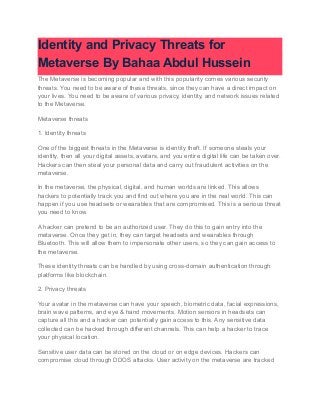Identity and Privacy Threats for Metaverse By Bahaa Abdul Hussein.pdf
- 1. Identity and Privacy Threats for Metaverse By Bahaa Abdul Hussein The Metaverse is becoming popular and with this popularity comes various security threats. You need to be aware of these threats, since they can have a direct impact on your lives. You need to be aware of various privacy, identity, and network issues related to the Metaverse. Metaverse threats 1. Identity threats One of the biggest threats in the Metaverse is identity theft. If someone steals your identity, then all your digital assets, avatars, and you entire digital life can be taken over. Hackers can then steal your personal data and carry out fraudulent activities on the metaverse. In the metaverse, the physical, digital, and human worlds are linked. This allows hackers to potentially track you and find out where you are in the real world. This can happen if you use headsets or wearables that are compromised. This is a serious threat you need to know. A hacker can pretend to be an authorized user. They do this to gain entry into the metaverse. Once they get in, they can target headsets and wearables through Bluetooth. This will allow them to impersonate other users, so they can gain access to the metaverse. These identity threats can be handled by using cross-domain authentication through platforms like blockchain. 2. Privacy threats Your avatar in the metaverse can have your speech, biometric data, facial expressions, brain wave patterns, and eye & hand movements. Motion sensors in headsets can capture all this and a hacker can potentially gain access to this. Any sensitive data collected can be hacked through different channels. This can help a hacker to trace your physical location. Sensitive user data can be stored on the cloud or on edge devices. Hackers can compromise cloud through DDOS attacks. User activity on the metaverse are tracked
- 2. by service providers. There is a serious potential for misuse here. The digital footprints of users can be accessed by hackers, who can then stalk them in the real world 3. Network threats While cloud computing is popular for use in the metaverse, it can be vulnerable to SPoF or Single Point of Failure. DDOS or Distributed Denial of Service attacks overwhelm the servers. This can lead to network problems on the metaverse. Services that use voting or reputation can be accessed by Sybil adversaries. Such attacks can impact the system effectiveness. The personal safety of users as well as safety of infrastructure is at risk. All these make it inevitable to increase security to protects users on the metaverse. Bahaa Abdul Hussein


